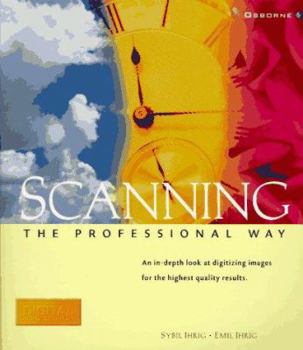Scanning the Professional Way
Improve your scanning skills selectively and quickly with this comprehensive and tightly focused book. The authors draw on their long-standing professional expertise in publishing, design, and digital... This description may be from another edition of this product.
Format:Paperback
Language:English
ISBN:0078821452
ISBN13:9780078821455
Release Date:August 1995
Publisher:McGraw-Hill/Osborne Media
Length:148 Pages
Weight:0.95 lbs.
Dimensions:0.5" x 8.0" x 9.1"
Customer Reviews
3 ratings
The non-designers scan and print book review
Published by Thriftbooks.com User , 24 years ago
This book contains 263 pages packed full of information guarrantteed to get any designer or non-designer off to a good start. The title is a little deceptive however because this book offers so much more than just tips on scanning. In fact it could be accused of being over ambitious. None the less, it is educationally sound in that it starts with the basics and then moves onto more complex issues such as traping and digital proofing. This book is easy to read and the colloquialisms and humour through out make the journey even more pleasurable. Chapter topics include: Know where you are going, the basis of desktop printing, the basics of commercial printing, different types of computer applications, computer colour modes, raster images and resolutions, vector images, file formats, process and colour printing, spot colours and duotones, specifying the number of colours, scanners and scanning, digital cameras and kodak digital CD, stock photos and clip art, fonts and outlines, high resolution output, output specifications, trapping, proofing your job, preflight check list, quizzes and projects. Whew! At just $US24.99 this book represents value for money. Sadly, given its subject matter this book will date quickly. Also, people needing indepth information about any of the topics covered in this book will be dissappointed however, this is something this book does not promise to deliver.
Excellent abbreviated source on basics.
Published by Thriftbooks.com User , 26 years ago
It's not a very professional posture to adopt, but I really like the personable nature of the text...it's an enjoyable read simply on the basis of its personality!I appreciated a concise comparison of various file type and compression scheme options, and have already recommended the book to one of my customers and one of my competitors.One thing is missing from this book and its genre-a guide on what maximum resolution a variety of media will accomodate. For example, Kodak Safety Film, circa 1965, ASA100, or modern consumer and professional films. Is 5,000spi beyond the capability of particular stock?I suppose that there could be more on scanning older monochrome stock too...but the book is focused and very useable.Strong recommend.
Clear and concise how-to guide to scanning
Published by Thriftbooks.com User , 27 years ago
Unlike many of the computer tomes on the shelves today, this book is a model of brevity and clarity. This 150 page book is only a half inch thick, so its easy to carry and won't exhaust your bookshelf space. It will allow you to quickly understand what you need to know to get a quality scan. The explanations of screen frequency, dpi, lpi, etc. are the clearest I've seen. The images accompanying the text are very useful illustrations of the points in the text. However, if you're looking for a guide to a specfic brand scanner software, this is not the book for you. For the most part though, scanner software commands are quite similar, and this book clearly explain the effects of each






